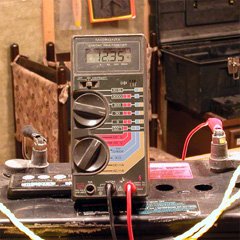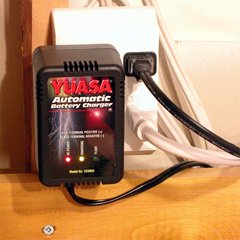Caring for Your Lead-Acid Field Battery
May 1, 2003 for QuietFlyer Magazine
The electric modeler uses a lead-acid battery as a source from which to recharge flight batteries, an application which uses a significant portion of the lead-acid battery’s capacity before it is recharged. Like our models’ power batteries, this field battery requires some care to ensure a long useful life.
Selection
Having the right battery is as important as taking care of it. Ordinary car batteries are not designed to be significantly discharged before being recharged. Starting a car takes less than 5% of the battery’s capacity, after which it is recharged during driving. The best type of battery for us is the deep-cycle battery, which as its name suggests, is designed to withstand cycles of fairly deep discharge. However, for maximum life, it’s better to not discharge to below 50% capacity.
Like the nickel-cadmium (NiCd) and other types of cells we use for electric flight, lead-acid batteries have an Amp-hour (Ah) rating. On some batteries, this is indicated directly. Others have a reserve capacity rating, which is the number of minutes that the battery can deliver 25 Amps before dropping to 10.5 Volts. This can be converted to Ah by dividing by 2.4. For example, a 180 minute battery has a 75Ah capacity.
To estimate the capacity you will need, use the following formula,
L = C × N × P × 0.3
where C is the Ah capacity of the NiCd or NiMH cells you typically use, N is the number of cells in each pack, P is the number of packs you will charge in one flying session, and L is the Ah capacity of the deep-cycle lead-acid battery you should buy. For example, if you will be charging five 10-cell RC2400 packs in a flying session, then L = 2.4 × 10 × 5 × 0.3 = 36Ah. (If you are using packs of seven cells or less, use 7 for N in the formula, because most chargers will draw as much current for fewer than seven cells as they will for exactly seven.)
If you are using lithium-polymer (LiPo) battery packs, use the same formula with the following differences: C is the Ah capacity of the cells, multiplied by the number of parallel cells in your packs, and N is the number of series cells in each pack, multiplied by 3. For example, if you will be charging five 4S2P packs of 2100mAh LiPo cells, then L = (2.1 × 2) × (4 × 3) × 5 × 0.3 = 76Ah.
Charging
After every flying session or after 30 days of non-use, recharge the battery. During the process of discharging a lead-acid battery, such as in a day’s flying, lead sulfate particles are formed. Recharging the battery will cause these to revert back to lead and sulfuric acid. If left to sit however, these particles can harden, clogging up the electrodes within the battery. Over time, as more and more of the electrodes become covered with lead sulfate, the battery’s capacity, and ability to deliver current, will decrease.
If your battery is one with removable caps, check the water levels and refill as necessary before charging. Use only distilled water (not tap water, filtered water, or mineral water). Wear safety glasses! The water should be above the tops of the lead plates, and well below the top of the battery. Follow the manufacturer’s directions for your particular battery to ensure the correct water levels.
It is important to use an appropriately sized charger. One that charges at too high a rate can cause the battery to overheat. One that charges at too low a rate may never achieve full charge. The appropriate size is one that will charge the battery in about 10 hours. Taking into account charging inefficiencies, this is about one-ninth of the Ah rating. For our 75Ah example, an 8.3A charger would be ideal. A commonly available 10A charger is fine.
The easiest kind of charger to use is an automatic one, which will charge the battery until it is full, and then either turn off, or switch to a float charge. If you have such a charger, you can leave it connected all the time between flying sessions. If the battery is old, check on the charger to be sure it actually reaches full charge. If it does not, the charger will continue to charge it at a fairly high rate, and eventually boil off all the electrolyte.
If you only have a manual charger, you will need to monitor the charging process. Using a digital voltmeter, monitor the battery voltage while connected to the charger. At room temperature, a reading of about 14.5V indicates that charging is complete. Disconnect the charger at that point.

A hygrometer lets you test each cell in a lead-acid battery individually. Be sure the hygrometer is clean before inserting it.
Always ensure adequate ventilation when charging a lead-acid battery. The charging process can give off hydrogen gas, which if allowed to build up in an enclosed area, is highly explosive. If at all possible, charge outdoors.
Testing
There are two easy ways to test the state of charge of a lead-acid battery. If it has just been charging, disconnect it from the charger for 24 hours before testing it.
If the battery has removable caps, the most reliable way to test it is with a hygrometer. This device sucks up a small amount of electrolyte (the sulfuric acid), and measures its density. The state of charge is directly related to the density, and most hygrometers will give you a 0% to 100% reading. A 12V battery has six cells, and you should check each one. All the readings should be close. If one is significantly off, it may indicate a bad cell, or the need for an equalization charge.

The 12.35V reading on the digital voltmeter indicates a 67% charge, agreeing with the hygrometer. Be sure to measure at room temperature, at least 24 hours after charging.
The other way to test the battery is with an accurate digital voltmeter. Again, wait 24 hours after charging before testing. Unlike a NiCd battery, which with no load shows full voltage even when almost dead, a lead-acid battery’s voltage is proportional to its state of charge. The table below shows the relationship at room temperature (68°F or 20°C):
| Voltage | Charge |
|---|---|
| 12.62 | 100% |
| 12.42 | 75% |
| 12.21 | 50% |
| 12.03 | 25% |
Conclusion
Proper care of the battery is essential to long life. Well-maintained, a deep cycle battery used for weekend flying can last for ten years. Poorly looked after, it can die in a year or two.
Related Articles
If you've found this article useful, you may also be interested in:

If you've found this article useful, consider leaving a donation in Stefan's memory to help support stefanv.com
Disclaimer: Although every effort has been made to ensure accuracy and reliability, the information on this web page is presented without warranty of any kind, and Stefan Vorkoetter assumes no liability for direct or consequential damages caused by its use. It is up to you, the reader, to determine the suitability of, and assume responsibility for, the use of this information. Links to Amazon.com merchandise are provided in association with Amazon.com. Links to eBay searches are provided in association with the eBay partner network.
Copyright: All materials on this web site, including the text, images, and mark-up, are Copyright © 2025 by Stefan Vorkoetter unless otherwise noted. All rights reserved. Unauthorized duplication prohibited. You may link to this site or pages within it, but you may not link directly to images on this site, and you may not copy any material from this site to another web site or other publication without express written permission. You may make copies for your own personal use.


Jeremy
August 24, 2008
First, Stefan has apparent remarkable technical competence, and should be so noted.
I can only add to his lead-acid battery maintenance, 2 comments: 1) Keep top of your lead-acid battery clean/dry. To clean simply flush with plain water; do not use baking soda as if any seeps inside the cells, it will seriously degrade electrolyte. Dirty battery top will discharge across what otherwise appears to be "insulator". 2) "Sealed" lead-acid batteries still may have removable caps, but if trying to pry off seemingly sealed cap/s, be extra careful not to splash electrolyte as at the least you will burn holes in your clothes, to say nothing of eyes.
Rick Swan
April 03, 2011
Very helpful, thanks (=:
ravi khugshal
April 12, 2011
how i can find out all the farmulas of electrical testing for a lead acid batteries